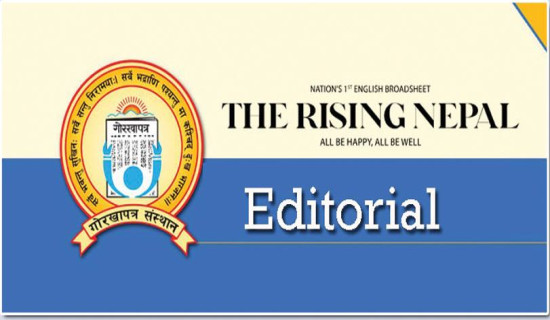- Wednesday, 19 February 2025
Drowning cases rise as people frequent pools amid rising heat
By Nayak Paudel,Kathmandu, May 8: The month of May marks the onset of summer in Nepal, and the days have already started getting hotter. To evade the heat, people have started visiting water sources to keep themselves cool.
However, it is not just the number of people visiting water sources on rise. According to Nepal Police Headquarters’ daily bulletins, cases of drowning have been a new normal recently.
Since the beginning of the Nepali New Year 2080 on April 14, 2023, until Saturday, May 6, 2023, the daily bulletins have recorded 26 deaths by drowning across the country. Among them, 17 were children.
On Saturday alone, five children drowned in different parts of the country.
Nine-year-old Mohammad Alkama Ansari and Mohammad Abdul Ansari, twin sons of Ali Hassan Ansari, drowned in the pond in front of the Gogal Prasad Namuna Secondary School in Ward No. 24 of Janakpur Sub-Metropolitan City in Dhanusha district.
Similarly, seven-year-old Roshani Lodh, daughter of Chandra Shekhar Lodh, drowned in the river in Ward No. 8 of Gaidahawa Rural Municipality in Rupandehi district.
In Baglung district’s Nisikhola Rural Municipality, Ward No. 6, five-year-old Sakira Budha, daughter of Chakra Bahadur Budha, drowned in the local Nisi River. Khagendra Nepali, 17, also drowned in the Lohore River in Ward No. 7 of Narayan Municipality in Dailekh district on Saturday.
According to concerned stakeholders, children and males with increased access to water are most at risk of drowning.
The World Health Organisation (WHO) states that the prevention efforts have mainly targeted recreational settings in high-income countries – not the day-to-day settings in low- and middle-income countries where the vast majority of drowning occurs, and where action is most urgently needed.
While around 90 per cent of global drowning deaths occur in low- and middle-income countries, such as Nepal, there is not only a lack of effective steps but also drowning-related data.
Nepal Police officers informed that they did not have proper data on drowning but were well aware that children and youths were the major victims.
According to them, children and youths enter a water source without knowing its depth and without the ability to swim.
Lack of physical barriers between people and water, particularly close to home, inadequate supervision of young children, and lack of water safety
awareness and risky behaviour around water, such as swimming alone, are said to be some major risk factors behind the worrying scenario of drowning.
Nepal Police Mirror 2022 also shows that out of the 6,792 suicides committed in 2021/22, 32 were due to drowning.
Even the WHO states that the global estimates may significantly underestimate the actual public health problem related to drowning in lack of concrete data.
Experts also suggest that parents should have a proper surveillance over their children as they can drown in small water bodies, such as ditches and water containers. On May 2, one-year-old Jitendra Mahato Kewat, son of Rasleela Mahato Kewat, drowned in a ditch nearby their house in Ward No. 5 of Kalikamai Rural Municipality in Parsa district while playing.
However, even adults can get drowned in small water bodies.
On April 27, 32-year-old Tara Bista got drowned in a small canal in Ward No. 10 of Punarbas Municipality in Kanchanpur district while she was trying to cross it to cut grass for the cattle.
Drowning is said to be the third leading cause of unintentional injury and death worldwide, accounting for seven per cent of all injury-related deaths. There are an estimated 236,000 annual drowning deaths worldwide.
Concerned government authorities, such as the National Disaster Risk Reduction and Management Authority (NDRRMA) and Nepal Police, have requested the public to not enter a water mass when alone, unable to swim and unknown of its depth.
The WHO also suggests preventive steps such as providing safe places away from water for pre-school children, install barriers controlling access to water, teach school-age children (aged over 6 years) swimming and water safety skills and train bystanders in safe rescue and resuscitation.
















